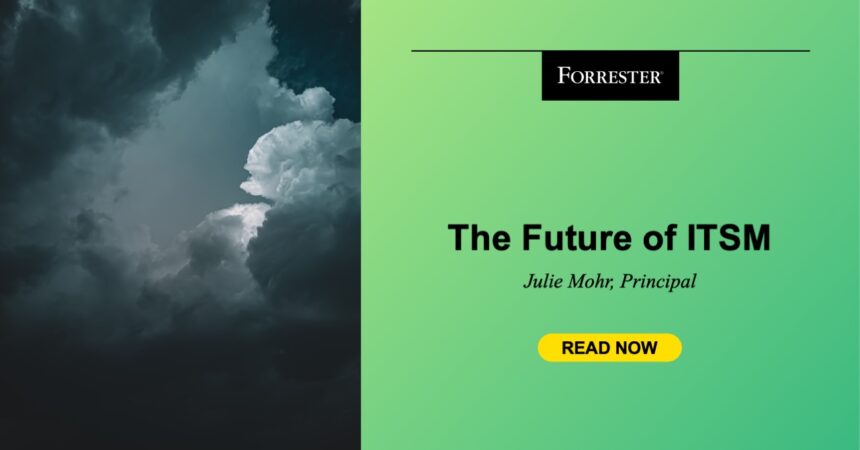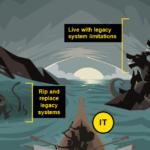The enterprise service management (ESM) and IT service management (ITSM) market is heading in an interesting direction. ESM/ITSM is a mature market pushing organizations toward a single platform to manage all enterprise operations. While the complexity and cost are significant, connections and communities drive innovations through collaboration. Seeing how these dynamics play out over the coming years will be compelling.
Our industry has some challenging dynamics that need to be solved: the value of connection and the complexity and costs that it entails. Let me break these down with my observations from our Forrester Wave™ analysis.
Connection Across The Enterprise
The benefits of having all your operations on a single platform are everything from better reporting to improved insights and an overall better understanding of the value streams that serve crucial stakeholders. Better insights mean organizations can make iterative improvements to service delivery. But more than just insights, the ITSM/ESM platform can improve knowledge flow connecting across teams and collaboration. Instead of information locked in functional silos, teams can query across the value stream to identify delay gates and new ways to innovate.

ESM/ITSM platforms also improve collaboration through additional functionality, including chatbots and integration with applications such as Teams and Slack. They automatically collect information shared in a chat channel and link it to a related record, such as an incident or change. Many of the vendors also enable knowledge sharing across their entire ecosystem. Managed service providers and customers can share unique workflows with the community, thus creating an even more expansive knowledge flow. Instead of building these capabilities, the larger community can provide many more options and use cases and empower innovation across their ecosystem.
Complexity Of ITSM Platforms
Most organizations need a small army to manage their ITSM platform. Citizen development is not an option, as the low-code/no-code capabilities are still too difficult for business operations managers to figure out. The platforms come in many varieties and packages; figuring out what you need and not paying for capabilities you don’t need is difficult. One Forrester client indicated they had begun using a vital functionality in the lower-end package. When their contract renewal came around, that capability was randomly moved to the higher-priced package.
Implementation takes a long time, which can be explained when organizations move from zero to 60 miles per hour. But the return on investment takes way too long. Why? Because the platforms are implemented in ways that make it harder for them to achieve improved productivity (basically taking the old way of working and putting it into the new platform), or you are limited in your adoption by the resources that you can hire/train/partner with — which plain slows down your transformation. Whatever it is specifically, we have a complexity problem that needs to be addressed. An ESM/ITSM platform was supposed to help organizations make work visible, reduce friction, and simplify the management of the complex. And yet, the tool itself is the most complex of all.
Cost Of ITSM Platforms
As the platforms continue to expand in their capabilities, organizations make substantial investments to ensure they get the most from their service management platform. Who they partner with matters. The more your delivery organization puts its workflows into a single platform, the more tied an organization becomes. Choosing a vendor is like a marriage. The courting is the pre-sales and sales contact, and then once you sign the contract, you are in it for the long haul.
A platform that supports IT operations, enterprise workflows, asset management, and automation and provides AI/ML capabilities comes at a premium. ITSM/ESM platforms are feature-rich, with advanced modules for common business operations such as HR, facilities, customer service, sales, portfolio management, etc. As organizations expand the platform’s adoption across the enterprise, the costs for licenses and additional modules explode. While organizations expect to pay for these capabilities, pricing schemes vary significantly, with some vendors choosing full transparency and others using some magical formula that seems to vary by customer. Any organization spending a significant part of the budget must have clear and transparent pricing to manage current spending and project costs as the organization considers additional investments.
Budgeting Problems of ITSM
Another issue is that organizations typically keep the budget for these platforms only from the IT budget, even if the business units use it. As services are rationalized and moved to a single platform, the budget must be distributed to the business units. Otherwise, it looks like a costly IT platform.
Separating from your vendor is expensive, and you often give up capabilities for a cheaper solution. Moving from one platform to another is much like a divorce — you lose much of your historical data, investments in workflows, and integrations. It can take a good three years to recover your costs for transition, yet for some organizations, with the rising costs, it is the only path they can take.
Here is an informal poll that I conducted on LinkedIn; the results at this point support these observations:

Let’s Connect
In conclusion, it has been a month since the completion of my first Forrester Wave. If you are a Forrester customer, you can view the results of The Forrester Wave™: Enterprise Service Management, Q4 2023, on our customer portal. I learned a lot about the vendors in this market, their product offerings, and the broader ecosystem. I also learned how the Wave process works and its importance to all parties involved. Many people and companies dedicate a substantial effort to participate in evaluative research, and the amount of data required for that evaluation is massive. I thank all who participated!
Have questions? That’s fantastic. Let’s connect and continue the conversation! Please reach out to me through social media or request a guidance session. Follow my blogs and research at Forrester.com.








